Security Pattern – Container Orchestration
Overview
This security pattern outlines the controls needed to protect orchestration services used for deploying clustered containers.
Container orchestration enables provisioning and scaling of containers across multiple hosts and platforms. It also facilitates service registration and discovery for clustered container groups.

Common examples of technology vendors providing container orchestration include Kubernetes, HashiCorp Nomad, and Apache Mesos. These services inherently bring new security challenges due to the rapid pace of change and large scale of container deployments.
Typical Challenges
- Compromise of orchestration services or sub-components can lead to unauthorised access to containers or deployment of containers to unauthorised hosts. For example, a rogue workstation joining a container cluster could subsequently be allowed to deploy sensitive containers onto that host.
- Increased complexity and attack surface across orchestration services and multi-tenant container hosting. Managing configurations at scale across multiple container deployments and container hosting platforms increases the risk of human error or inadvertent changes that weaken security posture.
- Increased complexity in network micro-segmentation for container clusters. Ensuring appropriate policies for segregation of container-to-container communications becomes more challenging.
- Incident management and forensics become more difficult, as containers can be restarted and destroyed, limiting the ability to investigate the root cause of infections, compromises, or impacts.
Scope
The scope of this document is for addressing the security threats that relate to
| ID | Description | Example |
|---|---|---|
| 01 | Container orchestration across multiple hosts | Deployment of Kubernetes across Docker hosting platform. |
Out of Scope
| ID | Description of exclusion | Reason for Exclusion |
|---|---|---|
| 01 | Deployment of Service Mesh architectures across clustered containers | Service Mesh deployments are closely related to Container Orchestration. These patterns are maintained separately due to the different associated security challenges. |
| 02 | Protection of Container Platform | Covered separately under a different security pattern |
| 03 | Container platforms integration with DNS services | DNS is a core capability for supporting container orchestration but requires separate consideration of security challenges. |
Dependencies
| ID | Description | Impact from dependency not met |
|---|---|---|
| 01 | Summarised security design principles outlined under Jericho Forum® Commandments. https://publications.opengroup.org/w124 | Minimal impact as these principles are used as an example set of baseline requirements within security pattern. |
Constraints
| ID | Description | Impact from constraint |
|---|---|---|
| 01 |
Assumptions
| ID | Description | Impact if assumption is false |
|---|---|---|
| 01 | Assets are assumed to have criticality ratings of either ‘Non-Critical’ or ‘Critical’. | Minimal. Values only used for demonstrating the solution within security pattern |
| 02 | Assets are assumed to have data classification ratings of either ‘Internal’, ‘Sensitive’ or ‘Highly Sensitive’ | Minimal. Values only used for demonstrating the solution within security pattern |
| 03 | Assets are assumed to be exposed to different network security domains of either ‘Public’, ‘Partner’ or ‘Internal’ | Minimal. Values only used for demonstrating the solution within security pattern |
Assets at Risk
The following section provides a list of assets affected by the problem statement:
| Asset Title | Asset Description |
|---|---|
| Orchestration Scheduler and Resource Manager | Provisions and deploys container clusters across target container host platforms based on prescribed cluster configurations. Monitors overall container cluster service state, container failures, and system resources. |
| Orchestration Metadata Datastore | Maintains metadata information for host platforms, containers, and services. This includes metadata associated with registration, inventory, and configuration for these assets. |
| Container Host Platform | Hosting platform for containers, including the container host operating system, container engine, and any local orchestrator agents required for container scheduling and health checks. |
| Container Network Services | Overlay network fabric and supporting services including NAT, proxy, and load balancing. These services provide ingress and egress connectivity for containers to endpoints located outside the container cluster. Services may be co-located on the same system as the Container Host Platform or hosted as a gateway service. |
The following assets are also referenced within the pattern but not in scope
- CI/CD Pipelines and Tooling – Broader orchestration services for supporting assets. Covered under separate security pattern.
Threat Model
The following section provides a list of threats within the problem statement:
| Threat Event (ID / Title) | Threat Description and Characteristics | Diagram |
|---|---|---|
| TE-11: Disruption to information systems due to misconfiguration or maintenance errors | Unintended changes in orchestration configuration, metadata, or network policy may disrupt container clusters or their supporting system resources. These changes can occur through human error by orchestration system administrators or due to unnecessary privileges granted to developers deploying Application Containers. | 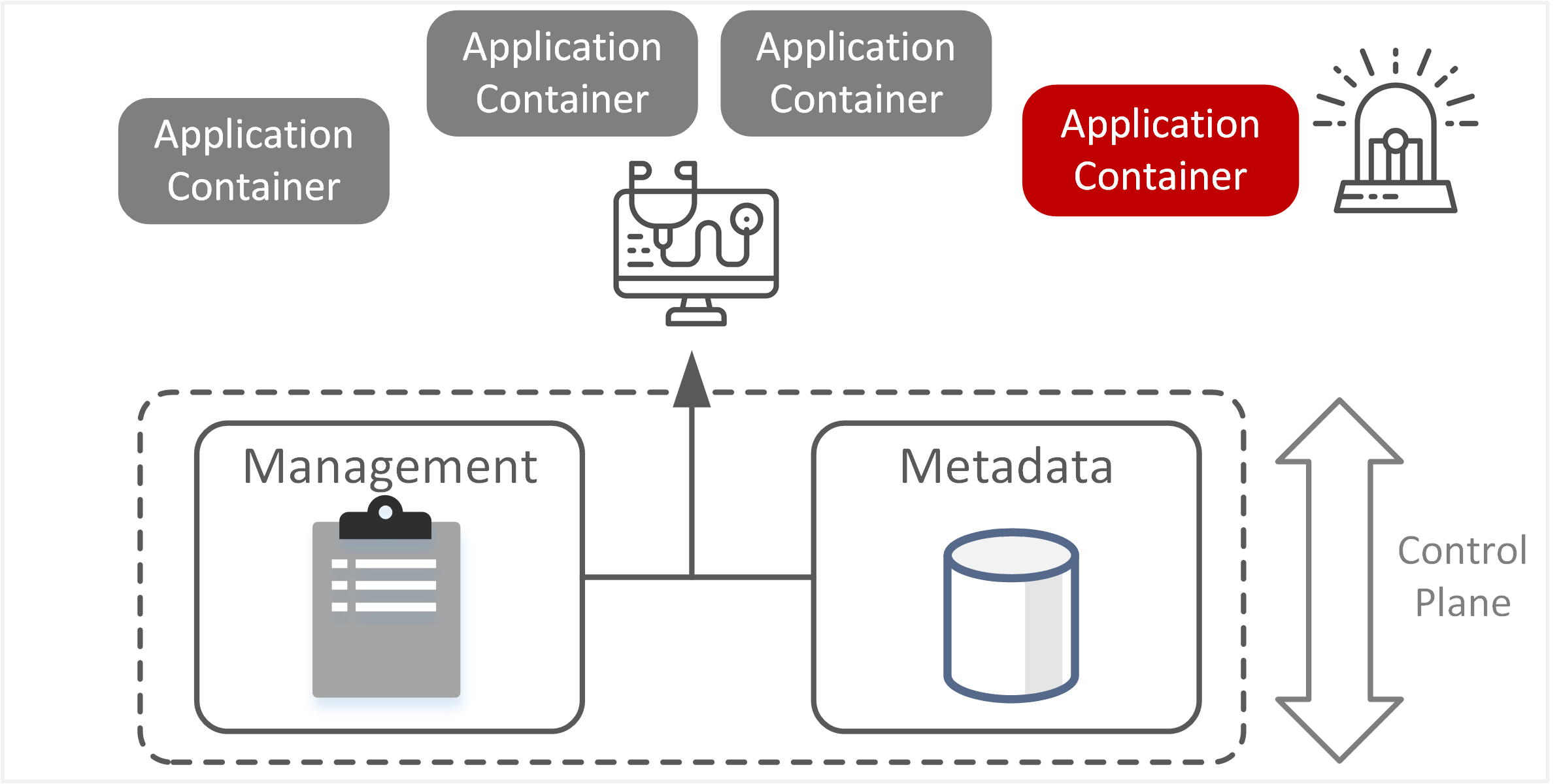 |
| TE-23: Man-in-the-middle attack or network traffic modification | Compromise or eavesdropping of communications between orchestrator services, container host platform, and related sub-components. This could allow a malicious entity to disable or disrupt applications through replay attacks or manipulation of network packets associated with administrative functions. | 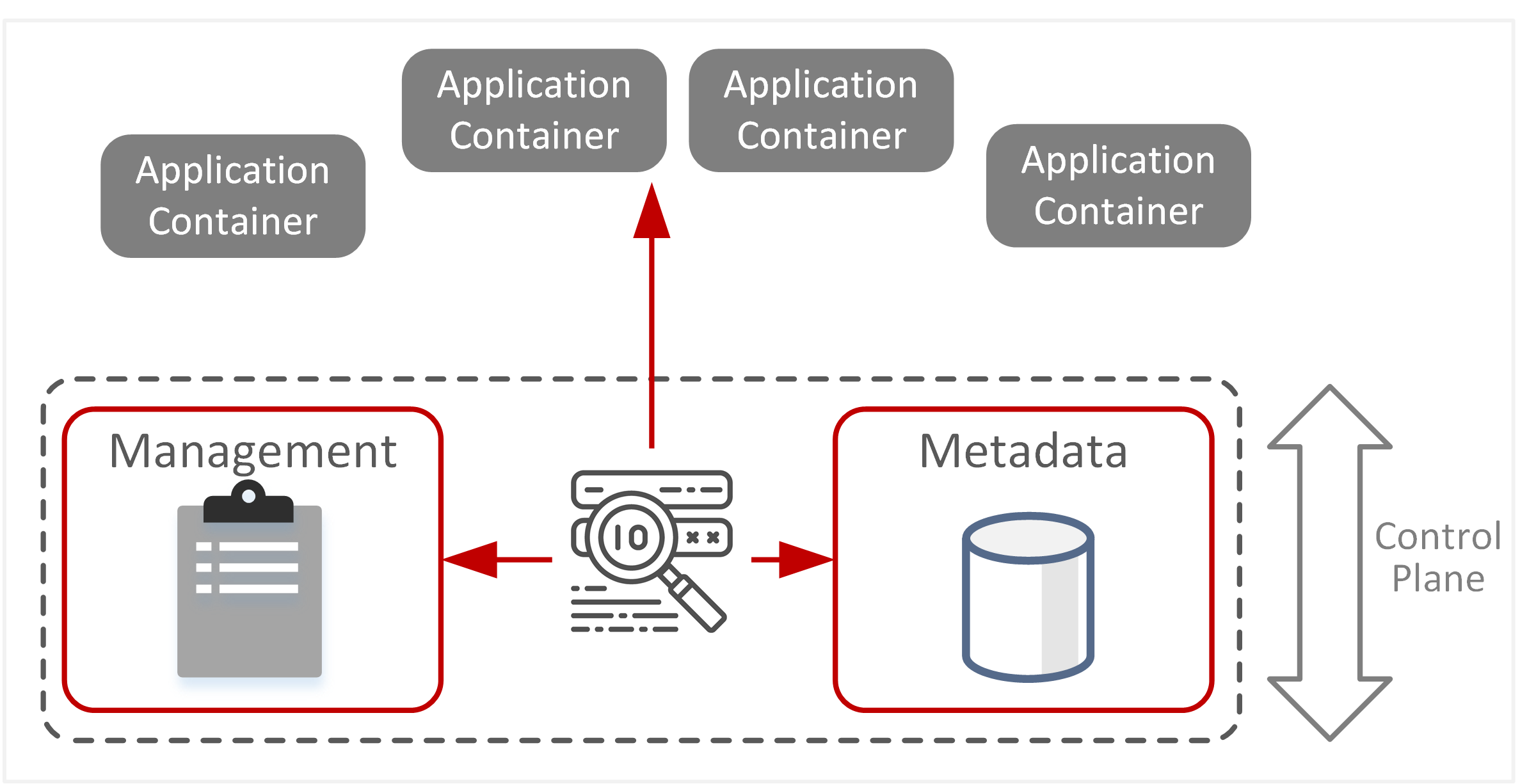 |
| TE-25: Generation of false identities | Compromise of system credentials or secrets stored in orchestration metadata may lead to the creation of false identities. This could allow unauthorised container host platforms to impersonate legitimate users or the insertion of rogue hosts that are mistakenly considered trusted platforms. | 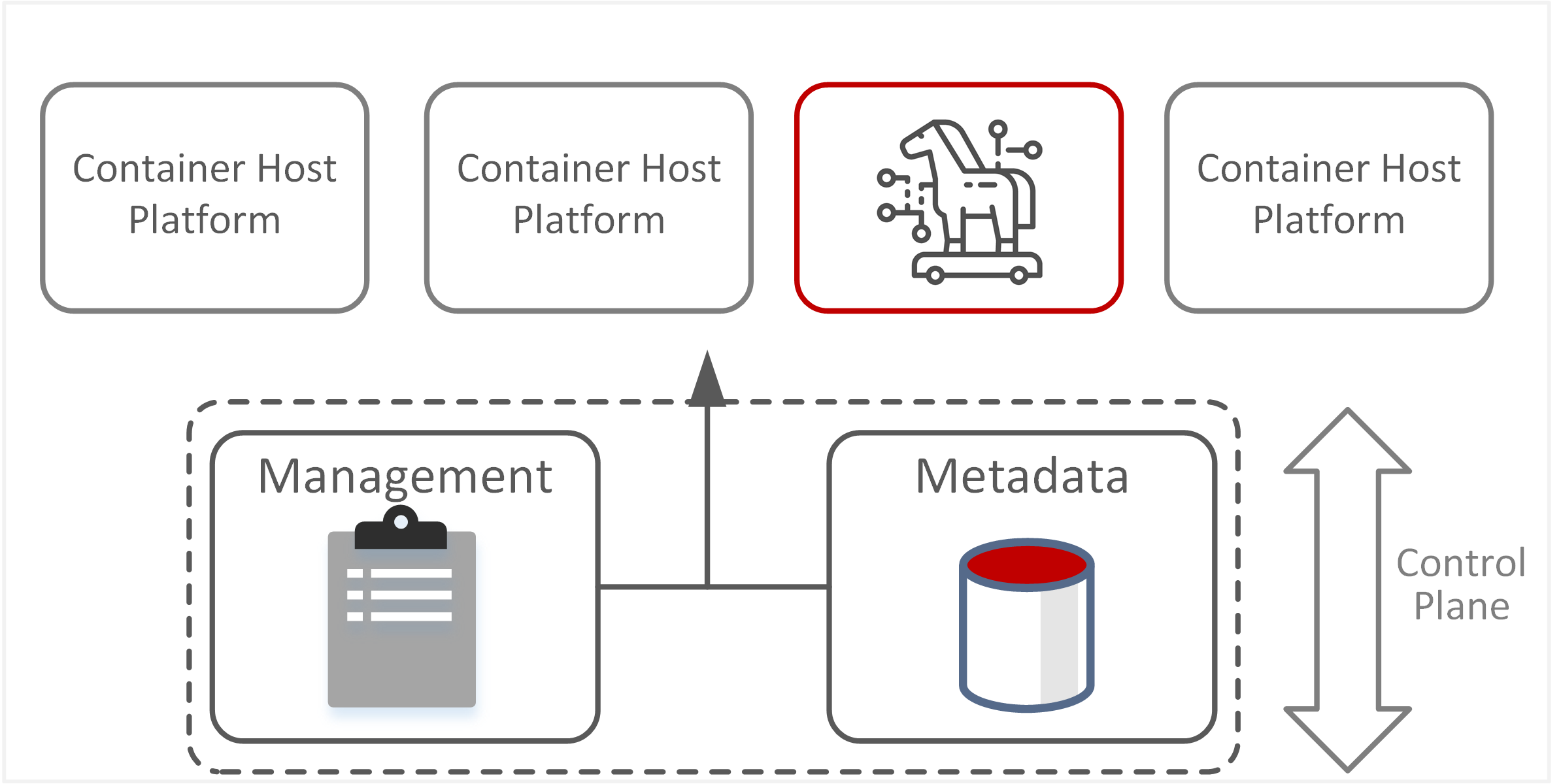 |
| TE-26: Abuse of resources through misconfiguration | Deliberate manipulation of orchestration services and functions to disrupt or disable applications within clustered containers. Compromising the integrity of the metadata database or making intentional changes to scheduler configuration may cause unavailability of services essential for operating and deploying container clusters. | 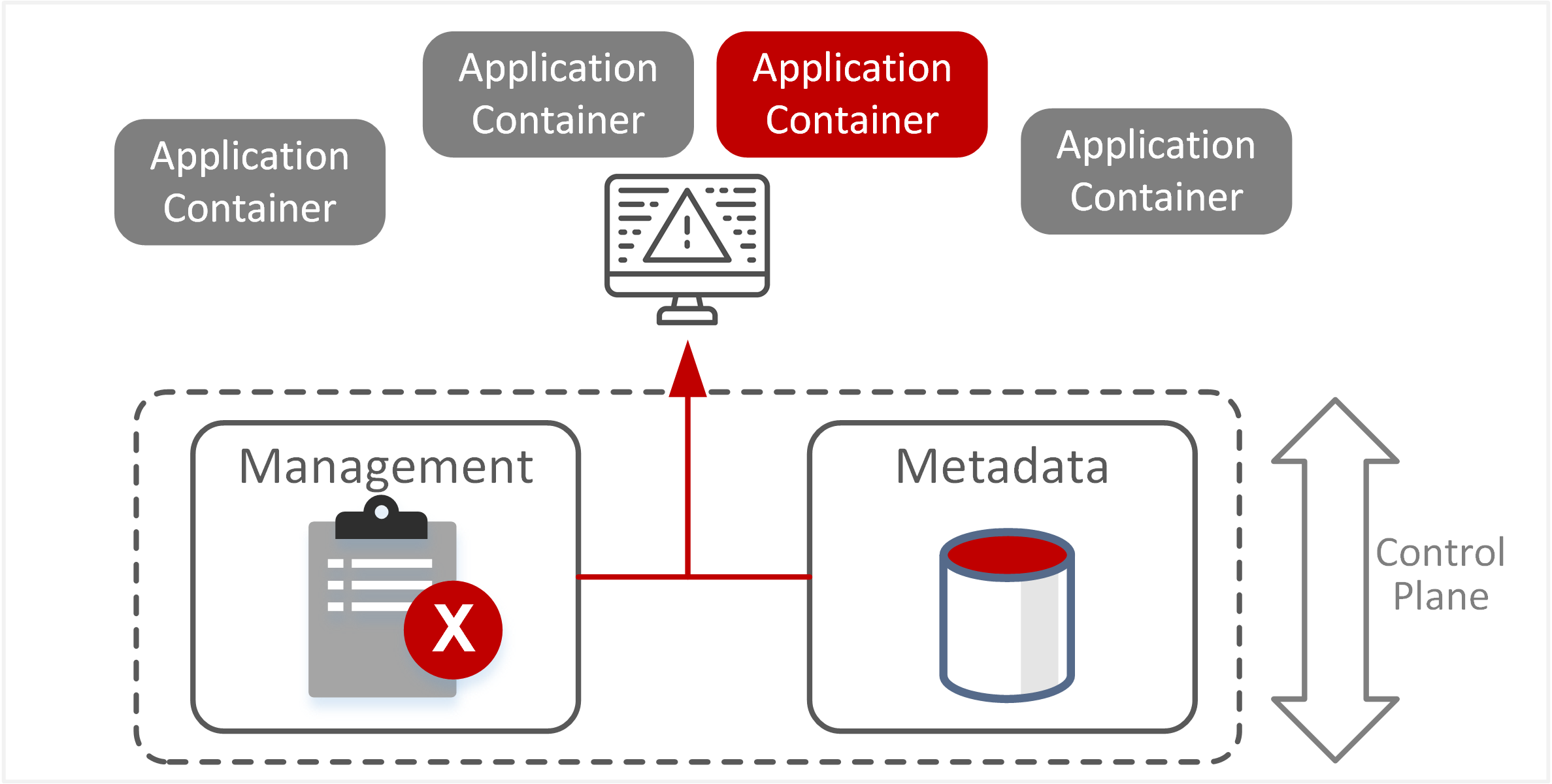 |
| TE-35: Lack of security insights to detect security threats | Increased complexity in detecting and investigating malicious activity or rogue processes within containers. This complexity stems from the rapid pace of changes made by container orchestration. Insights to track events or actions within containers can be limited when orchestration services automatically destroy and redeploy containers flagged as inactive or unhealthy. This restriction hinders the ability to conduct forensics for clustered containers, especially when manual intervention or tasks are required. |  |
Target State Solution
Summary
The target state solution evaluates the following design requirements to provide the expected target state solution and design principles.
Design Requirements
The target state solution is required to meet the following requirements, as referenced under Dependencies, Assumption and Constraints.
| Requirement | Implication to Design Principles |
|---|---|
| 1. The scope and level of protection should be specific and appropriate to the asset at risk. | Maintain segregated domains for host container platforms with different sensitivity and criticality |
| 2. Security mechanisms must be pervasive, simple, scalable, and easy to manage. | The security pattern maintains clear security principles to be applied for container orchestration. |
| 3. Assume context at your peril. | Controls defined in this security pattern are used to identify and measure problems, limitations or issues |
| 4. Devices and applications must communicate using open, secure protocols. | Open and encrypted communication channels such as HTTPS are applied for interfaces to container orchestration services |
| 5. All devices must be capable of maintaining their security policy on an un-trusted network. | Container Orchestration is protected against both external and internal threats. |
| 6. All people, processes, and technology must have declared and transparent levels of trust for any transaction to take place. | Validate container host platforms before joining orchestration cluster |
| 7. Mutual trust assurance levels must be determinable. | Establish mutual trust between container orchestration services and container host platforms |
| 8. Authentication, authorization, and accountability must interoperate/exchange outside of your locus/area of control. | Apply authentication and authorization for both internal, partner and public clients. |
| 9. Access to data should be controlled by security attributes of the data itself. | Utilise secrets management to protect secrets or sensitive information required during container deployment |
| 10. Data privacy (and security of any asset of sufficiently high value) requires a segregation of duties/privileges. | Utilise secrets management for securing sensitive data or credentials. |
| 11. By default, data must be appropriately secured when stored, in transit, and in use. | Protect containers both during deployment and run time. Isolate containers suspected of compromise |
Solution Overview
The orchestration of Application Containers across multiple hosting platforms is divided into segregated deployments. Security categorization levels determine how containers are deployed and isolated between Container Host Platforms operating within different security groups.

Additional Notes
- Enforce restrictions for any hosts attempting to join clusters from other security domains such as Public, Partner or End User locations.
- Services and sub-components within the orchestration control plane establish mutual trust and communicate across protected channels (where supported).
- Metadata datastore operates as source of truth for container security categorisation information, regardless if applied as security attributes or tagging to each container.
Security categorisation levels
The rationale for segregation is to minimize the potential for compromise of services or traffic between Application Containers with different security posture requirements. These ‘protection ratings’ are associated with additional assurance for controls implemented to protect critical or sensitive Application Containers.
Containers receive a security categorization based on:
- Exposure to external sources
- Criticality of the application services running within the containers
- Sensitivity of data being transferred or processed within the containers
The following provides attributes (with example values) for modeling segregation associated with ‘protection ratings’:
| ID | Description | Values |
|---|---|---|
| 1 | Exposure of application services running within the containers |
|
| 2 | Criticality of the application services running within the containers |
|
| 3 | Sensitivity of data being transferred or processed within the containers |
|
The ‘protection ratings’ for establishing boundaries between Container Host Platforms are subsequently calculated based on the following tiering model.
| Internal (Non-Critical) | Partner (Non-Critical) | Public (Non-Critical) | Internal (Critical) | Partner (Critical) | Public (Critical) | |
|---|---|---|---|---|---|---|
| Internal | Default | Default | Default | Default | Protected | Protected |
| Sensitive | Default | Default | Default | Protected | Protected | Protected |
| Highly Sensitive | Protected | Protected | Protected | Highly Protected | Highly Protected | Highly Protected |
See notes in Assumptions for listed sample values. Values provided are for demonstrating the segregation model are will differ for each organisation.
Isolating Compromised Containers
For Application Containers suspected of compromise or breach, the following containment measures can be taken:
- Snapshot the compromised Application Container.
- Redeploy to an isolated security forensics environment for investigation.
- Scale down the Application Container cluster to zero using Container Orchestration services to prevent similar containers from being compromised.
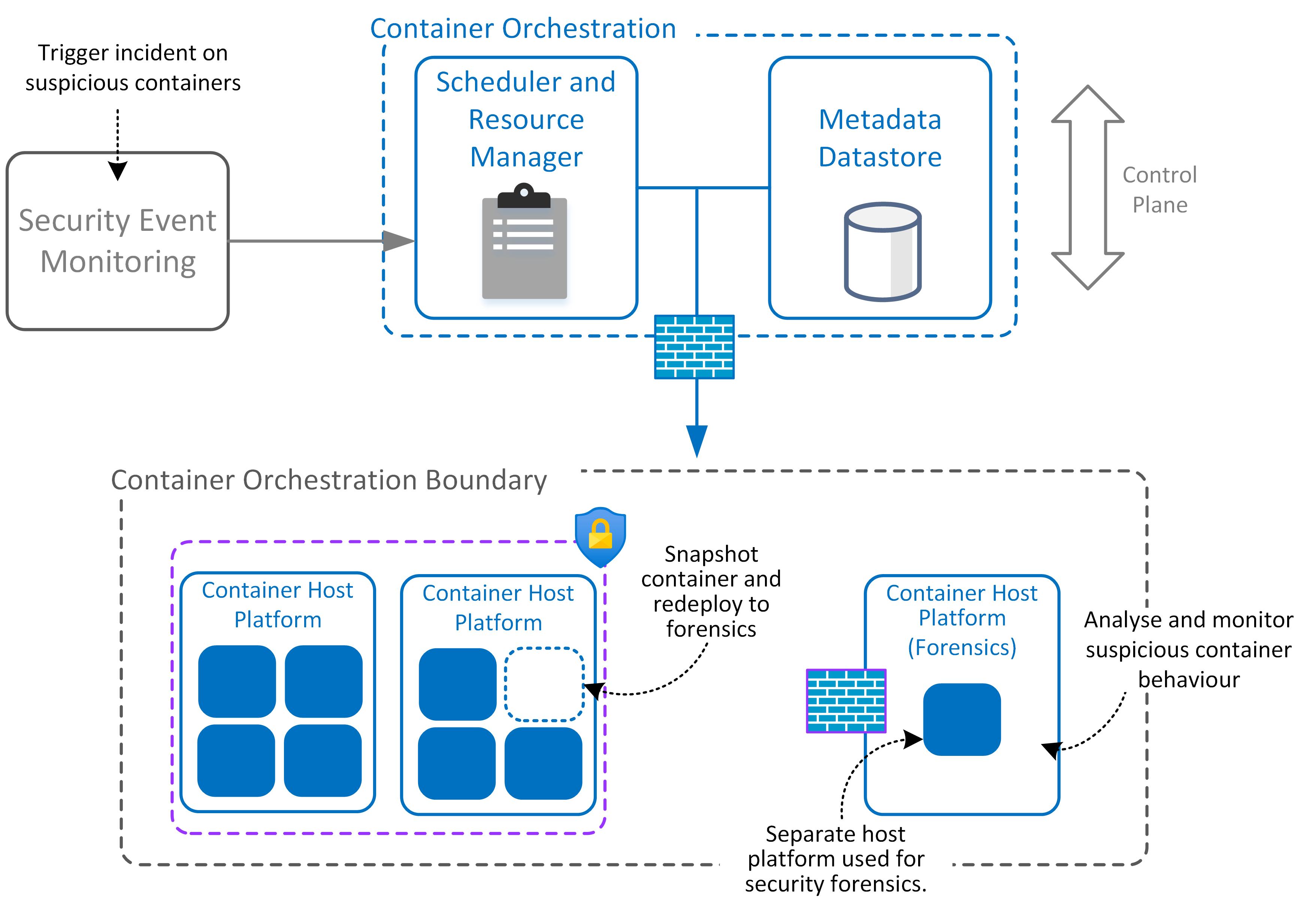
Additional Notes
- Ensure automation security processes and workflows within orchestration services where supported. Allow automated triggering of workflows based on orchestration events or CI/CD pipelines (where applicable for deployment)
Design Principles
The following design principles are applied for this pattern, based on the requirements.
- Tightly restrict cluster-wide administrative access within Container Orchestration.
- Segregate container deployments to host platforms based on security categorisation for sensitivity and criticality.
- Apply tighter access restrictions to those containers exposed to external clients.
- Ensure that container host platforms are securely introduced to the cluster.
- Isolate container suspected of compromise and remove from cluster.
Actors
List the actors involved in this pattern.
| Actor Type | Actor Description |
|---|---|
| Container Orchestration Administrator | Responsible for management and administration of orchestration services. |
| Container Platform Administrator | Responsible for management and administration of Container Engine and Container Host Operating System |
| Application Developer | Design, build and deployment of microservice applications within Application Containers. |
Locations
This pattern is applied to any locations for assets being utilised
| Location | Location Description |
|---|---|
| Container Hosting Platform | These platforms are deployed within trusted internal hosting environments, hosted within on-premise or cloud provider environments. |
Sequencing
The pattern is designed within the following sequences
| Stage gate | Description |
|---|---|
| Container Cluster Deployment | Orchestration services manage how and where containers are being deployed. Includes the scale of deployment, policies governing communications and container privileges assigned. |
| Container Cluster Run Time | Execution and operations for active container clusters that are successfully deployed |
Mapping Threats to Controls
The following provides a mapping of security threats to affected assets and the security control objectives required to mitigate them (further detailed in subsequent security pattern logical designs).
| Threat Event | Affects Assets | Security Controls Objectives |
|---|---|---|
| TE-11: Disruption to information systems due to misconfiguration or maintenance errors | Orchestration Scheduler and Resource Manager | AC-06: Least Privilege
AU-02: Event Logging CM-02: Baseline Configuration CM-05: Access Restrictions for Change CP-09: System Backup CP-10: System Recovery and Reconstitution |
| TE-23: Man in the middle attack or network traffic modification | Container Network Services | AC-04: Information Flow Enforcement
AC-12: Session Termination SC-02: Separation of System and User Functionality SC-03: Security Function Isolation SC-07: Boundary Protection SC-08: Transmission Confidentiality and Integrity SC-11: Trusted Path SC-37: Out-of-band Channels |
| TE-25: Generation of false identities | Orchestration Metadata Datastore
Container Host Platform |
AC-03: Access Enforcement
AC-06: Least Privilege SC-03: Security Function Isolation SC-17: Public Key Infrastructure Certificates SR-09: Tamper Resistance and Detection |
| TE-26: Abuse of resources through misconfiguration | Orchestration Scheduler and Resource Manager
Orchestration Metadata Datastore |
AC-03: Access Enforcement
AC-14: Permitted Actions Without Identification or Authentication AU-02: Event Logging CM-02: Baseline Configuration CP-09: System Backup CP-10: System Recovery and Reconstitution IA-09: Service Identification and Authentication MA-03: Maintenance Tools RA-02: Security Categorization RA-05: Vulnerability Monitoring and Scanning SC-32: System Partitioning SI-04: System Monitoring SR-09: Tamper Resistance and Detection |
| TE-35: Lack of security insights to detect security threats | Container Host Platform | AU-02: Event Logging
AU-09: Protection of Audit Information IR-04: Incident Handling IR-05: Incident Monitoring IR-08: Incident Response Plan IR-10: Incident Analysis |
Security Pattern
Pattern View: Container Orchestration

Control list: Orchestration Scheduler and Resource Manager
| Control Objective | Control Description |
|---|---|
| AC-03: Access Enforcement | Restrict administrative access to orchestration service interfaces and API’s, through IAM policies or source IP whitelisting. |
| AC-06: Least Privilege | Define granular RBAC model, with least privilege defined for actions and roles on specific hosts and containers. Minimise the use of wildcard policies for applying defined roles. Allocation of cluster-wide administrative accounts are tightly controlled. |
| AC-14: Permitted Actions Without Identification or Authentication | Disable any unauthenticated or anonymous access to orchestration services. |
| AU-02: Event Logging | Enforce event logging across orchestration services and sub-components. Forward and capture log events to external security logging and monitoring service. |
| CM-02: Baseline Configuration | Ensure baseline security configuration for orchestration services are hardened to industry or vendor best practise (e.g. CIS Security Benchmark), including system permissions for configuration files and services. Ensure regular patching cycles are applied. |
| CM-05: Access Restrictions for Change | Ensure multi-factor authentication is applied for administrator accounts with access to orchestration services, particular those accounts with cluster-wide privileges. |
| CP-09: System Backup | Regular scheduled backups are applied for orchestration system information, configuration and metadata datastore. Ensure mechanisms employed to protect the integrity of system backups. |
| CP-10: System Recovery and Reconstitution | Ensure reconstitution for orchestration services and restoration of container clusters back to operational states. |
| IA-09: Service Identification and Authentication | Orchestrators ensure that containers are securely deployed to the cluster with a unique and persistent identity throughout their lifecycle. Minimise the use of any shared credentials for service accounts used for orchestration or administrative functions. |
| MA-03: Maintenance Tools | Validate any 3rd party components, modules or plugin services integrated within orchestration services or performing management functions. |
| RA-02: Security Categorization | Categorise and group Container Host Platforms into logical entities based on sensitivity and criticality of hosted Application Containers. Isolate sensitive workloads and specify multiple containers with same protection ratings categorization to run on the same host OS. Maintain the source of truth for this information within purpose metadata datastore. |
| RA-05: Vulnerability Monitoring and Scanning | Regularly monitor and scan for vulnerabilities in the orchestration system and related sub-components |
| SC-32: System Partitioning | Isolate within separate security groups or segments for Container Host Platforms. Ensure separate system partitioning of orchestration control plane from those systems used within Container Host Platforms. |
| SI-04: System Monitoring | Compare and analyse different runtime activity in containers within same deployments for given environment. Deviations in network activity, active processes or behaviour between similar deployed containers are flagged as Indicators of Compromise (IOC). If suspected compromised, trigger forensics on suspicious containers and then scale to zero or terminate any containers within that cluster. |
| SR-09: Tamper Resistance and Detection | Ensure authentication and mutual trust is applied within sub-components of orchestration services and metadata service to |
Control list: Orchestration Metadata Datastore
| Control Objective | Control Description |
|---|---|
| AC-03: Access Enforcement | Restrict administrative access to metadata service interfaces and API’s, through IAM policies and or source IP whitelisting. |
| AC-06: Least Privilege | Minimise any administrative privileges to perform direct changes within metadata datastore. |
| AC-14: Permitted Actions Without Identification or Authentication | Disable any unauthenticated or anonymous access to metadata datastore. |
| CM-02: Baseline Configuration | Ensure baseline security configuration for orchestration services are hardened to industry or vendor best practise (e.g. CIS Security Benchmark), including system permissions for configuration file and services. |
| CP-09: System Backup | Regular scheduled backups are applied metadata datastore. Ensure mechanisms employed to protect the integrity of system backups. |
| CP-10: System Recovery and Reconstitution | Ensure reconstitution for orchestration services and restoration of container clusters back to operational states. |
| IA-09: Service Identification and Authentication | Maintain accurate inventory and security-related attributes of clustered containers respective container host platforms. |
| RA-05: Vulnerability Monitoring and Scanning | Regularly monitor and scan for vulnerabilities in the orchestration metadata services and related sub-components. |
| SC-03: Security Function Isolation | Any storage or caching of secrets within meta-data services and read-able configuration files are protected using purpose-built secrets management service. This includes security-related attributes of clustered containers used for security categorisation. These secrets are made available during both deploy and runtime of container clusters. |
| SC-13: Cryptographic Protection | Ensure metadata datastore is encrypted at rest. |
| SC-32: System Partitioning | Ensure separate system partitioning of Orchestration Metadata services and datastore from those systems used within Container Host Platforms. Isolate within separate security groups or segments. |
Control list: Container Host Platform
| Control Objective | Control Description |
|---|---|
| AC-03: Access Enforcement | Enforce access restrictions for local orchestration agents or services operating on Container Host Platform. All container deployment or configuration changes originate from Orchestration Scheduler and Resource Manager. |
| AC-06: Least Privilege | Restrict and tighten permissions for local orchestration agents or services. Permissions are assigned under dedicated role. |
| AU-02: Event Logging | Enforce event logging across Container Host Platform and system components. Forward and capture log events to external security logging and monitoring service. |
| CM-02: Baseline Configuration | Ensure baseline security configuration for orchestration services are hardened to industry or vendor best practise (e.g. CIS Security Benchmark), including system permissions for configuration files and services. |
| IR-04: Incident Handling | Ensure forensic tooling in provisioned on each Container Host Platform, to allow capture container file-system changes, container memory and any shared volumes. |
| IR-05: Incident Monitoring | Compare and analyse different runtime activity in containers within same deployments for given environment. Deviations in network activity, active processes or behaviour between similar deployed containers are flagged as Indicators of Compromise (IOC). |
| IR-08: Incident Response Plan | Trigger forensics to snapshot container as soon as possible, to reduce potential loss of events or actions. Once forensics is captured, terminate container instance(s) from cluster. If the incident is suspected to escaped container isolation, then additional capture snapshot for host OS. |
| IR-10: Incident Analysis | Security forensics are automated to capture container file-system changes, memory and shared volumes. |
| SC-03: Security Function Isolation | Container Host Platform supports integration for secrets management. |
| SC-17: Public Key Infrastructure Certificates | Use certificates issued from trusted certificate authority. |
| SR-09: Tamper Resistance and Detection | Validate integrity and authenticity for local orchestration agents or services operating on Container Host Platform. |
Control list: Container Network Services
| Control Objective | Control Description |
|---|---|
| AC-04: Information Flow Enforcement | Remove unnecessary, unused or insecure communication flows for container clusters. In particular reviewing any ports externally exposed outside container clusters for ingress or egress flows for Container Host Platforms with higher protection ratings (For example ‘Protected’ and ‘Highly Protected’) |
| AC-12: Session Termination | Any TLS offload to load balancing maintains micro-segmentation and boundaries. |
| SC-02: Separation of System and User Functionality | Maintain separate polices and controls for orchestration management traffic (including sub-components for system daemons or agents) and data traffic associated application containers. |
| SC-07: Boundary Protection | Apply segmentation policies between Container Host Platforms for different protection ratings (for example – ‘Default’, ‘Protected’ and ‘Highly Protected’). Tightly restrict connectivity for platforms with higher protection ratings. |
| SC-08: Transmission Confidentiality and Integrity | Encrypt container to container data traffic and exchange within container overlay network fabric. |
| SC-11: Trusted Path | Ensure trusted and mutually authenticated connectivity between orchestrator services and Container Host Platform. Restrict attempted registration of Container Host Platforms from unknown or untrusted network segments to Orchestration services. |
| SC-03: Security Function Isolation | Preference deployment of container-based firewall filtering, packet inspection and content inspection where supported. |
| SC-37: Out-of-band Channels | Ensure network visibility is integrated within container overlay network fabric and services. |
Appendix A – References
Please see below links to external sites for further reading
- https://www.stackrox.com/post/2019/09/docker-security-101/
- https://docs.docker.com/network/overlay/
- https://www.redhat.com/en/topics/containers/kubernetes-architecture
- https://dzone.com/articles/docker-containers-and-kubernetes-an-architectural
- https://www.stackrox.com/post/2017/08/csi-container-edition-forensics-in-the-age-of-containers/
- https://neuvector.com/container-security/cryptojacking-crypto-mining-tesla-kubernetes-jenkins-exploits/
- https://nvlpubs.nist.gov/nistpubs/SpecialPublications/NIST.SP.800-190.pdf
- https://coreos.com/rkt/#security
- https://sookocheff.com/post/kubernetes/understanding-kubernetes-networking-model/
Appendix B - Disclosure Notice
This document is published as independent research only and is without warrenty. It does not represent any publication from National Institute of Standards and Technology (NIST) or other associated US government entities.
